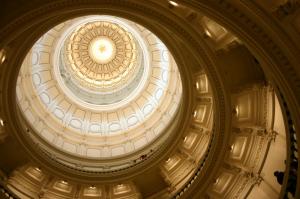
It’s no secret that the Texas Legislature faces a daunting budget problem, with deficits estimated to be as little as $15 billion or as much as $27 billion or more. Constitutionally speaking, however, the actual deficit is about $4.3 billion. That’s the difference between what was appropriated for the 2010-2011 biennium and the revenue the Comptroller of Public Accounts says is now available to pay for it. According to the Texas Constitution, the Legislature must come up with $4.3 billion by August 31 to balance the budget. The larger numbers reported in the media refer to the difference between the Comptroller’s estimated revenue for the next biennium (2012-13) and interpretations of maintaining a “current” level of services under existing law. In any event, the actual deficit and the anticipated shortfall seem to be a lot bigger than Texans have seen in a long time. Is this really the case?
Yes—and no. The “modern” history of the Texas budget process dates from 1949, when the Legislative Budget Board was created to oversee the legislative appropriations process. Since then Texas has experienced several periods of boom and bust, usually (but not always) at times of national economic slowdowns. The price of oil and gas has historically served as an important indicator of Texas’ budget health. When energy prices are high—the 1970s, much of the 1990s, and again in the mid-2000s—Texas has generally generated budget surpluses. Even while the rest of the country was mired in inflationary and economic malaise in the mid-1970s, Texas was awash in cash from record tax revenues. When energy prices decline, whether as a consequence of slowing demand or oversupply, as they did in the mid-1950s, mid-1980s, the early 2000s, and again two years ago, state tax revenues tend to follow, triggering budget shortfalls.
In fact, a worldwide decline of oil prices triggered the extended fiscal crisis that resulted in the introduction of the Texas sales and use tax in 1961. Throughout the 1960s, the Legislature paid for an expanding state economy by slowly increasing those tax rates, but the last of these rate bumps occurred in 1971, two years prior to the first OPEC oil embargo. That energy crisis was a disaster for the national economy, but a boon for Texas, which rode the wave of high gas prices for more than a decade. The party ended in 1986-87, when changes in passive income provisions of the federal tax code helped crater the banking, savings and loan, and energy sectors of the Texas economy. Ironically, while the rest of the country was emerging from recession in the latter half of the 1980s, Texas was wallowing in red ink. In 1987 Texas faced its largest budget deficit in modern history, and the Legislature responded with a $5.7 billion tax increase—by far the largest tax bill in Texas history up to that time (and since).
The national recession that followed the September 11 attacks created another major headache for Texas legislators. Just prior to the beginning of the 2003 legislative session, the Comptroller dropped her revenue estimate by $10 billion, creating a budget gap estimated at more than 12% of the current spending level at the time, in addition to an almost $2 billion actual deficit (about 3% of general revenue spending). Unlike in 1987, however, the Legislature dealt with the problem largely through accounting measures and budget cuts, without increasing taxes. To put this in perspective, the 2011 picture is considerably worse than 2003: the $4.3 billion actual deficit amounts to almost 5% of current spending, and the estimated shortfall for the 2012-13 budget ranges from 18 to 26%, depending on whether it is measured against current spending (smaller) or current services (larger). On the other hand, 2011 looks only slightly worse than 1987, when the actual budget deficit ($1 billion) likewise exceeded 4% of spending and the shortfall (about $5.7 billion) topped 20 percent.
To say that 2011 presents the most serious budget crisis since the 1940s is probably not inaccurate, but it should be kept in mind that at least twice—in 1987 and 2003—the Legislature faced a problem of similar magnitude. How it will respond this time remains to be seen. State leaders have pledged that they will not raise taxes and there seems to be little appetite in the Legislature or in the electorate for a tax bill. Yet budget cuts may become so unpalatable, as they did in the wake of the 2003 legislative session, that legislators may opt to raise at least some additional revenue. Still, a major tax increase like the one in 1987 is unlikely. The only certainty is that the Legislature must adopt a budget within available revenue by midnight on August 31, 2011, subject to the Governor’s line item veto authority. The clock is ticking.
Sources:
Legislative Budget Board, http://www.lbb.state.tx.us/The_LBB/Agency/History.htm
Texas Comptroller of Public Accounts, 2012-13 Biennial Revenue Estimate
Texas Taxpayers and Research Association, “Comparing Texas Fiscal Challenges
Want to know more about the Texas Lege?
Texas Legislature Online
And here’s a great novel about Texas politics, published in 1961 and re-issued in 1995
Billy Lee Brammer, The Gay Place
photo: Wing-Chi Poon [CC-BY-SA-2.5] via Wikimedia Commons
The views and opinions expressed in this article or video are those of the individual author(s) or presenter(s) and do not necessarily reflect the policy or views of the editors at Not Even Past, the UT Department of History, the University of Texas at Austin, or the UT System Board of Regents. Not Even Past is an online public history magazine rather than a peer-reviewed academic journal. While we make efforts to ensure that factual information in articles was obtained from reliable sources, Not Even Past is not responsible for any errors or omissions.
